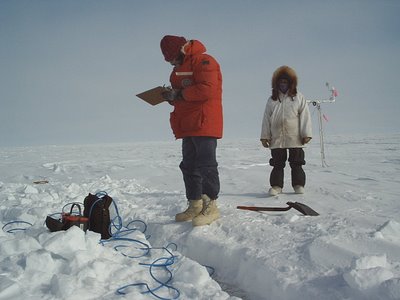Back in January, when Pat Cotter and I installed our wireless mass balance site, we also installed two strings of electrodes for Malcolm's experiments. The ice has since grown thicker - growing past the electrodes previously hanging down into the water. Each string has 19 electrodes spaced 10 cm apart. In the measurements, we inject an electrical current between two electrodes, one in each string, and then measure the voltage drop between two other electrodes. With 19 electrodes in each string, there are very many different possible combinations. We don't use all of them, just enough to get a clear image of the electrical resistivity of the ice between the two strings. This profile is related to the salt content of the ice, and how well-connected the salty brine inclusions are.
So far, so good: we've made one successful set of measurements, we've only seen prints but no bears, and Malcolm has had his first blast driving a snow machine. We'll also make measurements later in the season, when these measurements should be sensitive to rapid changes expected with warming above -5 C.
 Here's Malcolm making measurements with field support officer Scott Oyagak looking on (and for bears!)
Here's Malcolm making measurements with field support officer Scott Oyagak looking on (and for bears!)Hajo (left) cutting an ice core for salinity measurements to compare with the electrical measurements.

1 comment:
did you see the little emperor penguins march past? excellent protein source.
Post a Comment